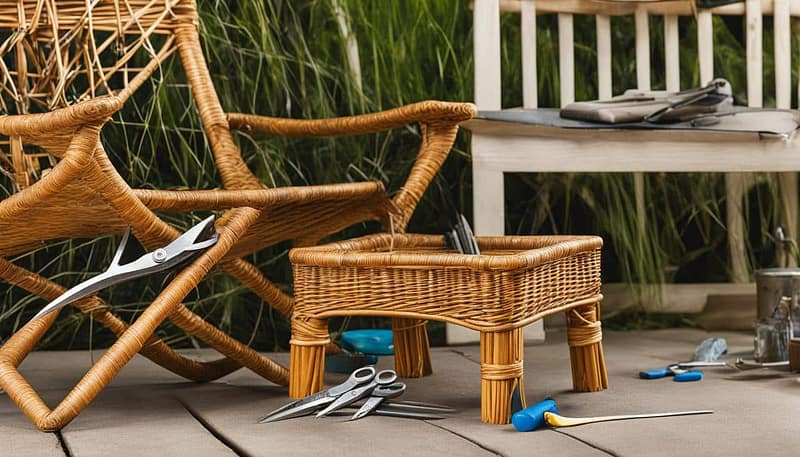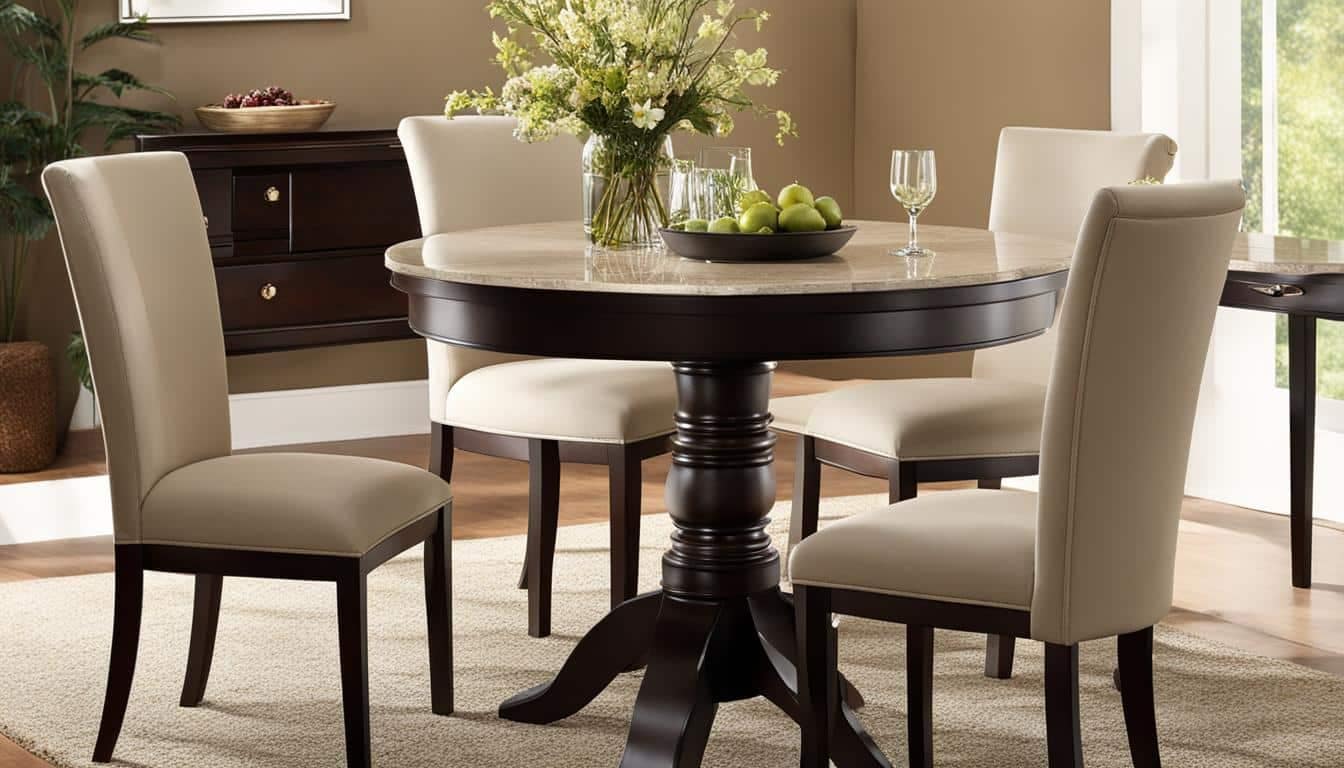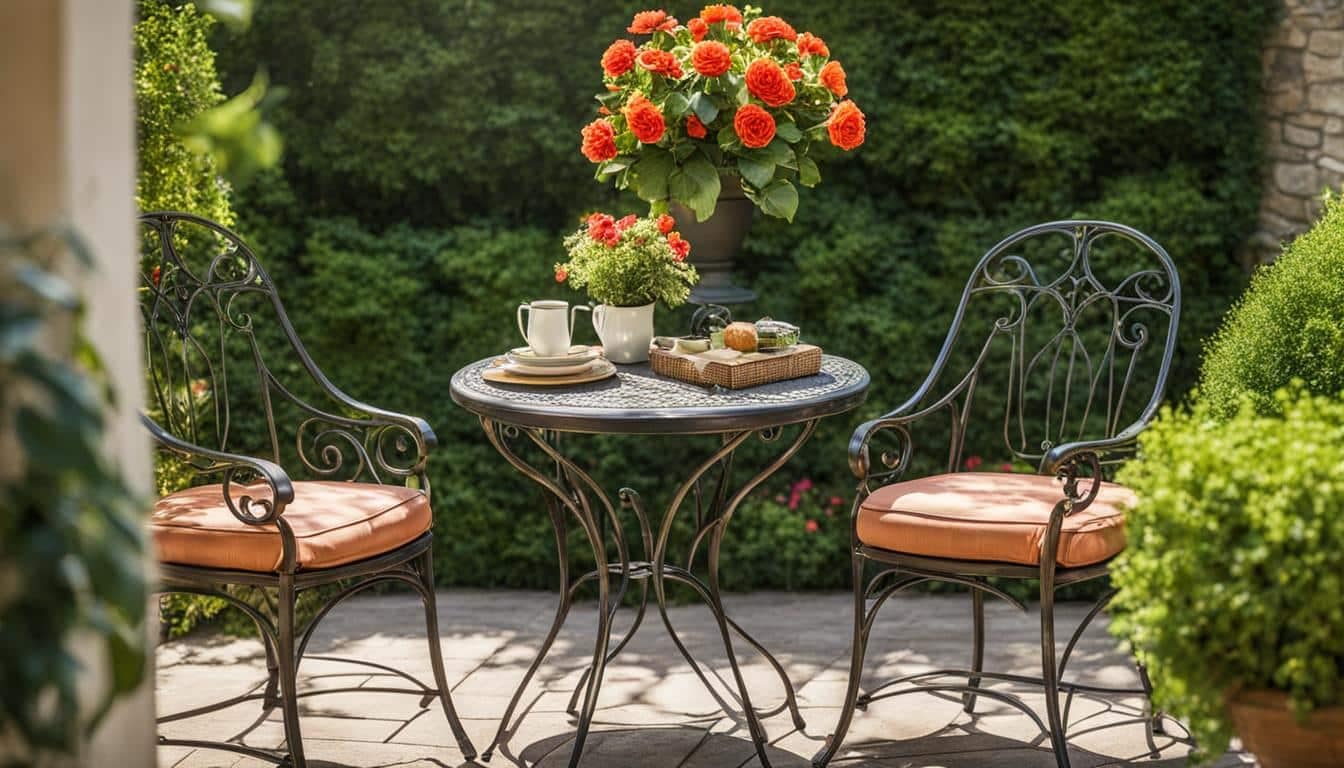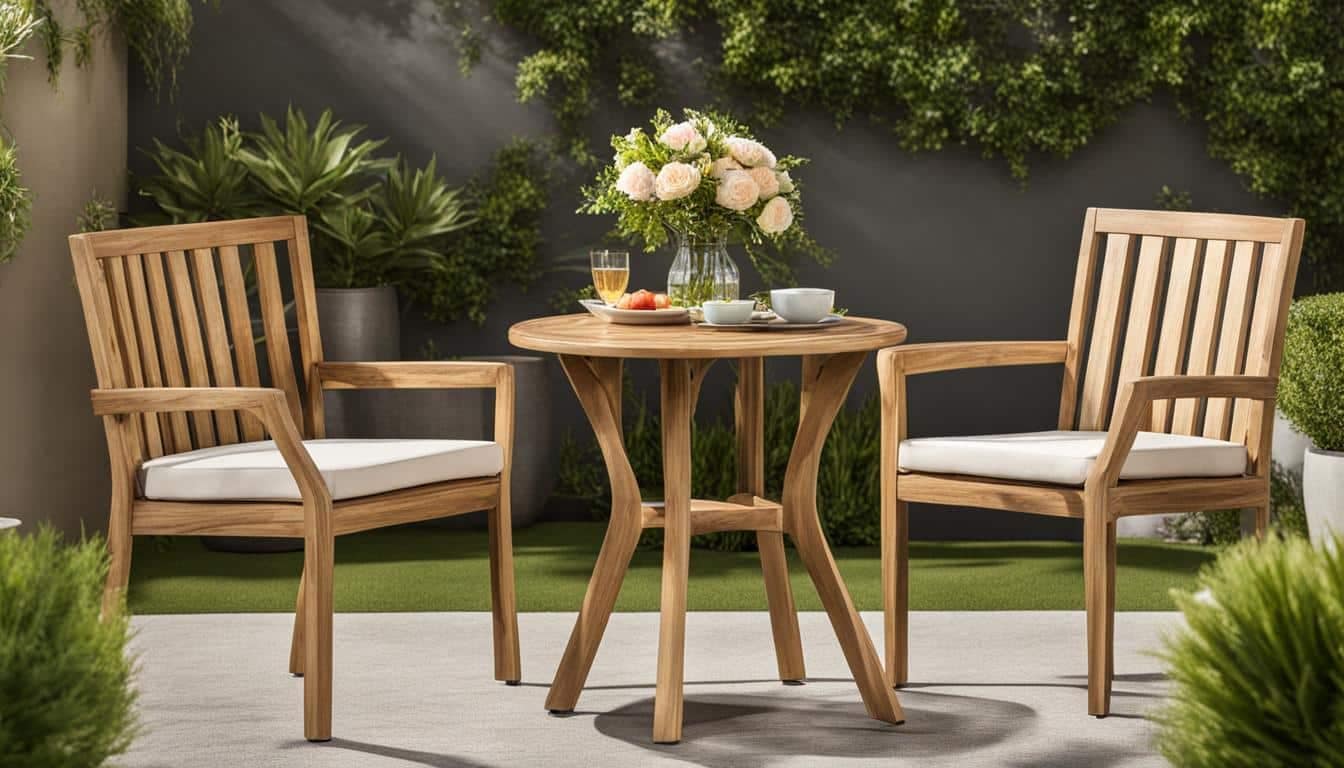Wicker furniture is cherished for its timeless style, natural aesthetic, and durability. However, over time, it can experience fading colors, broken weaves, and cracks. But don’t worry, with our comprehensive guide, you’ll learn how to repair and restore your wicker patio furniture with ease!
Key Takeaways:
- Learn the step-by-step process of fixing wicker patio furniture
- Discover techniques to tackle common issues like fading, broken weaves, and cracks
- Get tips on cleaning, prepping, and refinishing your wicker furniture
- Ensure the longevity of your furniture with proper maintenance and protection
- Save money and enjoy the satisfaction of DIY wicker furniture repair
Common Issues With Wicker Furniture
Wicker furniture, while beautiful and durable, can encounter several common issues over time. Fading and discoloration are often caused by prolonged exposure to sunlight, resulting in a loss of vibrancy. Broken or loose weaves can affect both the appearance and structural integrity of the furniture. Cracks and splits may also occur due to dryness or exposure to harsh elements. Understanding and addressing these common issues is essential in maintaining the beauty and functionality of your wicker furniture.
Fading and Discoloration
One of the most prevalent issues with wicker furniture is fading and discoloration. When exposed to sunlight, the natural colors of wicker can gradually fade, leading to a dull appearance. To combat this, you can restore the color and vibrancy of your furniture by using a wood stain or paint specifically designed for outdoor materials. Proper cleaning and surface preparation, such as removing dirt and debris, are crucial for a successful restoration.
Broken or Loose Weaves
Another common issue with wicker furniture is broken or loose weaves. These can be caused by regular wear and tear or inadequate maintenance. To repair broken weaves, you will need to clean the surface, trim the ends of the wicker, and check for any loose wrapping. Gently sand down any rough spots and weave in new strands to replace the damaged ones. Addressing this issue promptly will help prevent further damage and ensure the structural stability of your furniture.
Cracks and Splits
Cracks and splits can develop in wicker furniture due to dryness or exposure to harsh elements. Over time, these issues can compromise the overall integrity of the furniture. Repairing cracks and splits involves smoothing out rough edges with sandpaper, applying wood glue to the affected areas, and carefully holding the pieces together until the glue dries completely. This process restores both the appearance and strength of the furniture, extending its lifespan.
| Common Issues | Causes | Solutions |
|---|---|---|
| Fading and Discoloration | Prolonged exposure to sunlight | Use wood stain or paint for outdoor materials to restore color |
| Broken or Loose Weaves | Regular wear and tear, inadequate maintenance | Clean surface, trim wicker ends, weave in new strands |
| Cracks and Splits | Dryness, exposure to harsh elements | Smooth edges, apply wood glue, hold pieces together until dry |
Fading And Discoloration
Fading and discoloration are common issues that can occur with wicker furniture, particularly when exposed to sunlight. Over time, the vibrant colors of your wicker furniture may fade, leaving it looking dull and lackluster. However, there are effective ways to restore the color and vibrancy of your wicker furniture.
Tips to Restore Wicker Furniture Color
One of the most popular methods to restore color to faded wicker furniture is by using a wood stain or paint specifically designed for outdoor materials. Before applying any stain or paint, it is important to clean the surface of your furniture thoroughly and prepare it for restoration. This involves removing any dirt or debris that may have accumulated over time.
Once the surface is clean, you can proceed with applying the wood stain or paint. Choose a color that matches the original shade of your wicker furniture or opt for a new color to give it a fresh look. Apply the stain or paint evenly, making sure to cover all areas of the furniture. Allow it to dry completely before using the furniture again.
| Materials Needed | Instructions |
|---|---|
| Wood stain or paint |
|
By following these steps, you can easily restore the color of your wicker furniture and bring back its original beauty. Remember to regularly clean and maintain your wicker furniture to prevent further fading and discoloration in the future.
Broken Or Loose Weaves
Broken or loose weaves are common issues that can impact the look and structural integrity of your wicker furniture. If you notice any broken or loose weaves, it’s important to address them promptly to prevent further damage. Here are the steps to repair broken weaves:
- Start by cleaning the surface of the furniture to remove any dirt or debris.
- Using pliers, carefully remove the broken or loose pieces of wicker.
- Measure the length of new material needed to replace the broken weave.
- Soak the new strands of wicker in warm water for a few minutes to make them more pliable.
- Weave the new strands into the existing wicker, being careful not to pull too tight to avoid warping or distortion.
- Continue weaving until you have replaced the broken or loose weaves.
By following these steps, you can successfully repair the broken weaves in your wicker furniture and restore its original appearance and strength.
| Materials Needed | To Repair Broken Weaves |
|---|---|
| Pliers | To remove broken or loose wicker |
| New wicker strands | To replace broken or loose weaves |
| Warm water | To soak new wicker strands |
Cracks And Splits
If your wicker furniture has cracks or splits, don’t worry, it can be easily repaired. Follow these simple steps to fix wicker furniture cracks and splits:
- Start by smoothing out the rough edges around the crack or split using sandpaper. This will help create a clean surface for the repair.
- Apply wood glue to the cracked or split areas. Make sure to use enough glue to fill the entire gap.
- Press the cracked or split pieces together firmly and hold them in place. You can use a clamp or a heavy object to keep the pieces tightly secured while the glue dries.
- Allow the glue to dry completely before removing the clamp or heavy object. This may take a few hours or overnight, depending on the glue used.
Once the glue is fully dried, your wicker furniture will be restored and ready to use again. It’s important to note that repairing cracks and splits as soon as they appear will prevent further damage and prolong the lifespan of your furniture.
Preventing Cracks and Splits
To minimize the occurrence of cracks and splits in your wicker furniture, consider taking the following preventive measures:
- Avoid exposing your wicker furniture to extreme temperature and humidity variations, as they can cause the material to expand and contract, leading to cracks.
- Regularly clean and maintain your furniture to keep it in good condition. Remove any dirt or debris that may accumulate, as they can cause damage over time.
- Apply a protective finish, such as varnish or polyurethane, to your wicker furniture to create a barrier against moisture and prevent drying out.
By following these tips and properly maintaining your wicker furniture, you can enjoy its beauty and functionality for many years to come!
| Step | Actions |
|---|---|
| 1 | Smooth out rough edges using sandpaper |
| 2 | Apply wood glue to the cracked or split areas |
| 3 | Press the cracked or split pieces together and hold them in place |
| 4 | Allow the glue to dry completely |
Steps to Repair and Restore Wicker Furniture
Repairing and restoring wicker furniture is a rewarding DIY project that can breathe new life into your beloved pieces. By following these simple steps, you can easily restore the beauty and functionality of your wicker furniture:
Step 1: Clean and Prepare the Surface
Begin by thoroughly cleaning the wicker furniture with a mild oil-based soap and water solution. This will help remove any dirt, grime, or mildew that may have accumulated over time. Use a soft brush or cloth to gently scrub the surface, paying special attention to crevices and hard-to-reach areas. After cleaning, allow the furniture to dry completely before moving on to the next step.
Step 2: Replace Broken or Loose Weaves
Inspect the furniture for any broken or loose weaves. Using pliers, carefully remove the damaged pieces. Measure the length of new material needed and soak it in warm water to make it more pliable. Weave the new strands into the existing pattern, making sure to secure them firmly but not too tightly. Trim any excess material and tuck in the ends for a seamless repair.
Step 3: Repair Cracks and Splits
If your wicker furniture has cracks or splits, begin by lightly sanding the affected area to smooth out any rough edges. Apply wood glue to the cracked areas, making sure to spread it evenly. Press the pieces together and hold them in place using clamps or heavy objects until the glue dries completely. Once the glue has dried, gently sand the repaired area to achieve a seamless finish.
| Step | Instructions |
|---|---|
| Step 1 | Clean and Prepare the Surface |
| Step 2 | Replace Broken or Loose Weaves |
| Step 3 | Repair Cracks and Splits |
Step 4: Paint or Refinish the Furniture
To give your wicker furniture a fresh look, consider painting or refinishing it. Before applying any paint or finish, make sure the surface is clean and dry. Choose a high-quality paint or varnish specifically designed for outdoor use. Apply multiple thin coats, allowing each coat to dry thoroughly before applying the next. This will help ensure a smooth and long-lasting finish.
By following these steps, you can easily repair and restore your wicker furniture, bringing back its charm and durability. Regular maintenance, such as cleaning and protecting it from harsh outdoor elements, will help prolong its lifespan and keep it looking its best for years to come.
Cleaning And Preparing The Surface
Cleaning and preparing the surface of wicker furniture is an essential step in the repair and restoration process. Over time, exposure to harsh weather conditions and dew can cause mildew, leading to discoloration and fading. To ensure a successful restoration, thoroughly inspect the furniture for any damaged areas, such as broken weaves or cracks, and repair them before proceeding with painting or refinishing.
To clean the wicker furniture, you can use a mild oil-based soap mixed with warm water. Gently scrub the surface with a soft brush or sponge, paying close attention to any areas with stubborn dirt or stains. Rinse the furniture thoroughly with water and allow it to dry completely before moving on to the next step.
Once the furniture is clean, it’s important to prepare the surface by removing any peeling or chipping paint. Use sandpaper to gently sand away the old paint residue or varnish, creating a smooth and even surface for the new finish to adhere to. Be sure to wear protective gloves and a mask to avoid inhaling any dust particles. Take your time with this step to ensure the best results.
Table: Cleaning and Preparing Wicker Furniture Surface
| Steps | Instructions |
|---|---|
| Clean the surface | Mix a mild oil-based soap with warm water. Scrub the surface gently with a soft brush or sponge. Rinse thoroughly with water and allow it to dry completely. |
| Remove old paint | Use sandpaper to gently sand away peeling or chipping paint. Create a smooth and even surface for the new finish to adhere to. |
By cleaning and preparing the surface of your wicker furniture, you are ensuring that the subsequent repair and restoration steps will be more effective. This process removes dirt and grime while providing a suitable base for painting or refinishing. Taking the time to properly clean and prepare the surface will contribute to the overall success and longevity of your furniture restoration project.
Replacing Broken or Loose Weaves
When it comes to repairing broken or loose weaves in your wicker furniture, the process is relatively straightforward. Follow these steps to restore the integrity of your furniture:
- Start by carefully removing the broken or loose pieces using pliers. Take your time to avoid causing further damage.
- Measure the length of the new material needed to replace the broken weaves.
- Soak the new material in warm water to make it more pliable and easier to work with.
- Gently weave the new strands into place, taking care not to pull too tight to avoid warping or distortion of the furniture.
By replacing broken or loose weaves, you can improve the overall look and structural stability of your wicker furniture. Remember to match the new material with the existing weaves for a seamless repair.
Table: Materials Needed for Replacing Broken or Loose Weaves
| Materials | Description |
|---|---|
| Pliers | To carefully remove broken or loose weaves |
| New wicker material | To replace the broken or loose weaves |
| Warm water | To make the new wicker material more pliable |
Repairing Cracks And Splits
Cracks and splits can occur in wicker furniture over time, but with the right techniques, you can easily fix them and restore the integrity of your beloved pieces. The following steps will guide you through the repair process:
- Smooth out rough edges: Use sandpaper to gently smooth any rough edges around the crack or split. This will ensure a clean and even surface for the repair.
- Apply wood glue: Apply a generous amount of wood glue to the cracked areas. Make sure to distribute the glue evenly and cover the entire cracked surface.
- Hold the pieces together: Carefully align the cracked pieces and hold them together firmly. You can use clamps, heavy objects, or even strong tape to keep the pieces in place while the glue dries.
- Let the glue dry completely: Allow the glue to dry for the recommended duration specified on the product packaging. This will ensure a strong and durable bond.
By following these steps, you can mend wicker furniture splits effectively and ensure that your furniture retains its beauty and structural integrity.
Table: Comparison of Repair Methods
| Repair Method | Advantages | Disadvantages |
|---|---|---|
| Sanding and gluing | Relatively easy to do, cost-effective | May not be suitable for large or severe cracks |
| Wrapping with rattan or synthetic wicker | Can provide a seamless repair, suitable for larger cracks | Requires skill and expertise in weaving |
| Professional restoration | Guarantees a high-quality repair, suitable for valuable or antique pieces | Can be expensive, may require shipping the furniture |
When choosing a repair method, consider the severity of the cracks or splits, your skill level, and the value of the furniture. For minor cracks, sanding and gluing may be sufficient. However, for larger or more valuable pieces, it is recommended to consult a professional restorer.
Painting And Refinishing Wicker Furniture
When it comes to rejuvenating the look of your wicker furniture, painting and refinishing can work wonders. Before diving into the process, it’s important to thoroughly clean the furniture and remove any peeling or chipping paint. This will create a smooth surface for the paint or finish to adhere to.
If you prefer a painted finish, choose a high-quality outdoor paint that is specifically formulated for use on wicker furniture. Apply the paint in thin, even coats, allowing each coat to dry completely before applying the next. This will ensure a smooth and professional-looking finish. You can also experiment with different colors to match your outdoor decor.
If you prefer a more natural look, refinishing with tung oil or other wood finishes is a great option. These finishes penetrate the wicker, highlighting its natural beauty and providing protection. Apply the finish following the manufacturer’s instructions, and allow it to dry completely before using the furniture.
Maintenance Tips:
- Avoid placing hot objects directly on the painted or finished surface to prevent damage.
- Regularly clean the furniture with a mild soap and water solution to remove dirt and debris.
- Inspect the paint or finish periodically and touch up any areas that may have worn off or become damaged.
| Painting Wicker Furniture | Refinishing with Tung Oil |
|---|---|
| Pros | Pros |
| Provides an opportunity to add a fresh pop of color to your outdoor space | Enhances the natural beauty of the wicker while providing protection |
| Durable and long-lasting when applied correctly | Easy to apply and maintain |
| Allows for creative expression and customization | Does not require regular touch-ups or reapplication |
| Cons | Cons |
| May require more time and effort to achieve a smooth and even finish | Does not provide as much color variety as paint |
| May need regular touch-ups or repainting over time | May darken the wicker slightly, altering its original color |
Tips to Protect Wicker Furniture from Outdoor Elements
Wicker furniture is a beautiful addition to any outdoor space, but it requires proper maintenance and protection to ensure its longevity. By following these tips, you can keep your wicker furniture looking its best for years to come.
1. Apply a protective coating: To safeguard your wicker furniture from moisture and UV damage, consider applying a clear varnish or polyurethane topcoat. This will create a barrier that helps prevent fading, discoloration, and warping caused by exposure to the elements.
2. Regular cleaning: Keep your wicker furniture clean by regularly dusting it with a soft brush or cloth. For more thorough cleaning, use a mild oil-based soap mixed with warm water. Avoid using harsh chemicals or abrasive cleaners that can damage the wicker material.
3. Cover when not in use: When your wicker furniture is not in use, protect it from the elements by covering it with a moisture-resistant tarp. This will shield it from rain, snow, and direct sunlight, preventing potential damage and extending its lifespan.
Summary
Proper maintenance is essential to protect your wicker furniture from the outdoor elements. Apply a protective coating, regularly clean your furniture, and cover it when not in use. By following these simple tips, you can ensure that your wicker furniture remains beautiful and functional for years to come.
| Tips to Protect Wicker Furniture |
|---|
| Apply a protective coating |
| Regular cleaning |
| Cover when not in use |
Conclusion
In conclusion, repairing and restoring wicker patio furniture is a simple and effective way to prolong its lifespan and maintain its beauty. By addressing common issues such as fading, broken weaves, and cracks, you can easily bring your wicker furniture back to life.
Regular cleaning and maintenance play a crucial role in preserving the integrity of your wicker furniture. By following the steps outlined in this guide, you can ensure that your beloved pieces remain in excellent condition for years to come.
Remember to protect your wicker furniture from outdoor elements by applying a clear varnish or polyurethane topcoat. This will shield it from moisture and UV damage. Additionally, covering your furniture when not in use and avoiding prolonged exposure to direct sunlight will prevent fading and discoloration.
In summary, with the right techniques, tools, and ongoing care, you can easily repair, restore, and maintain your wicker patio furniture. By doing so, you can enjoy its timeless style and durability for many seasons ahead.
FAQ
What are the common issues with wicker furniture?
Common issues with wicker furniture include fading and discoloration, broken or loose weaves, and cracks and splits.
How can I restore the color of my wicker furniture?
To restore the color of your wicker furniture, you can use a wood stain or paint specifically designed for outdoor materials. Proper cleaning and surface preparation are essential for a long-lasting restoration.
How do I repair broken or loose weaves in my wicker furniture?
To repair broken or loose weaves, you will need to clean the surface, trim the ends of the wicker, and check for loose wrapping. Gently sand down rough spots and weave in new strands to replace damaged ones.
What should I do if my wicker furniture has cracks or splits?
If your wicker furniture has cracks or splits, you can smooth out rough edges with sandpaper, apply wood glue to the cracked areas, and hold the pieces together until the glue dries completely.
What are the steps to repair and restore wicker furniture?
The steps to repair and restore wicker furniture include cleaning and preparing the surface, replacing broken or loose weaves, repairing cracks and splits, and painting or refinishing the furniture.
How do I clean and prepare the surface of wicker furniture?
Cleaning and preparing the surface of wicker furniture involves removing any dirt or debris, inspecting for damaged areas, and sanding away old paint residue or varnish to create a smooth, even surface.
How can I replace broken or loose weaves in my wicker furniture?
To replace broken or loose weaves, carefully remove the damaged pieces, measure the length of new material needed, and soak it in warm water to make it more pliable. Weaving the new strands properly will restore the integrity of the furniture.
What is the process to repair cracks and splits in wicker furniture?
To repair cracks and splits in wicker furniture, you should smooth out rough edges with sandpaper, apply wood glue to the cracked areas, and hold the pieces together until the glue dries completely.
Can I paint or refinish my wicker furniture?
Yes, painting and refinishing wicker furniture is a great way to restore its look. Thoroughly clean the furniture, remove any peeling or chipping paint, and use a high-quality primer before applying paint or wood finishes.
How can I protect my wicker furniture from outdoor elements?
To protect your wicker furniture, consider using a clear varnish or polyurethane topcoat to prevent moisture and UV damage. Regular cleaning with a mild oil-based soap and water solution and covering the furniture with a moisture-protecting tarp when not in use are also recommended.
How can I maintain my wicker furniture?
Regular cleaning, maintenance, and proper protection from outdoor elements are key to preserving the beauty and longevity of your wicker furniture. Follow the repair and restoration techniques discussed in this guide, and clean your furniture with a mild oil-based soap and water solution regularly.







